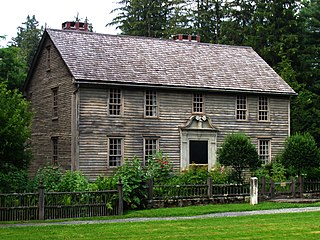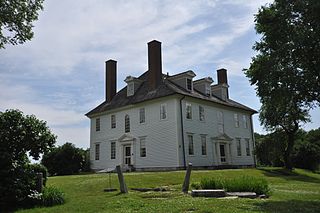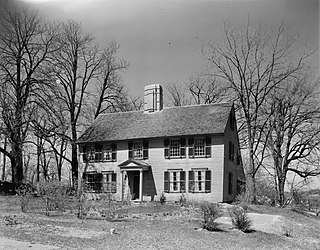
Acton is a town in Middlesex County, Massachusetts, United States, approximately 21 miles (34 km) west-northwest of Boston along Massachusetts Route 2 west of Concord and about ten miles (16 km) southwest of Lowell. The population was 24,021 in April 2020, according to the United States Census Bureau. It is bordered by Westford and Littleton to the north, Concord and Carlisle to the east, Stow, Maynard, and Sudbury to the south and Boxborough to the west. Acton became an incorporated town in 1735. The town employs the Open Town Meeting form of government with a town manager and an elected, five-member select board. Acton was named the 11th Best Place To Live among small towns in the country by Money Magazine in 2015, and the 16th best in 2009 and in 2011. The local high school, Acton-Boxborough Regional High School, was named a Blue Ribbon School by the U.S. Department of Education in 2009.

Thomas Hutchinson was a businessman, historian, and a prominent Loyalist politician of the Province of Massachusetts Bay in the years before the American Revolution. He has been referred to as "the most important figure on the loyalist side in pre-Revolutionary Massachusetts". He was a successful merchant and politician, and was active at high levels of the Massachusetts government for many years, serving as lieutenant governor and then governor from 1758 to 1774. He was a politically polarizing figure who came to be identified by John Adams and Samuel Adams as a proponent of hated British taxes, despite his initial opposition to Parliamentary tax laws directed at the colonies. He was blamed by Lord North for being a significant contributor to the tensions that led to the outbreak of the American Revolutionary War.

The John Adams Birthplace is a historic house at 133 Franklin Street in Quincy, Massachusetts. It is the saltbox home in which the second president of the United States, John Adams, was born in 1735. The house was designated a National Historic Landmark in 1960, and is listed on the National Register of Historic Places. It is now administered by the National Park Service as part of the Adams National Historical Park, and is open for guided tours.

Gore Place is a historic country house, now a museum, located at 52 Gore Street, Waltham, Massachusetts. It is owned and operated by the nonprofit Gore Place Society. The 45-acre (180,000 m2) estate is open to the public daily without charge; an admission fee is charged for house tours. A number of special events are held throughout the year including an annual sheepshearing festival and a summer concert series.

The Jeremiah Lee Mansion is a historic house located in Marblehead, Massachusetts. It is operated as a house museum by the local historical society. Built in 1768, it was designated a National Historic Landmark in 1960 as one of the finest Late Georgian houses in the United States. It features original wallpaper and finely-crafted woodwork.

The Mission House is an historic house located at 19 Main Street, Stockbridge, Massachusetts. It was built between 1739 and 1742 by a Christian missionary to the local Mahicans. It is a National Historic Landmark, designated in 1968 as a rare surviving example of a colonial mission house. It is now owned and operated as a nonprofit museum by the Trustees of Reservations.

The General Israel Putnam House in Danvers, Massachusetts, United States, is a historic First Period house recorded in the National Register of Historic Places. The house is also sometimes known as the Thomas Putnam House after Lt. Thomas Putnam (1615–1686), who built the home circa 1648. His grandson, Israel Putnam, the famous general of the American Revolution, was born in the house. Lt. Thomas Putnam was the father of Sgt. Thomas Putnam Jr.,, a notorious figure in the Salem witch trials. The Putnam House is now owned by the Emerson Family, the same owners of Putnam Pantry.

Belmont Center is an MBTA Commuter Rail station in Belmont, Massachusetts. It serves the Fitchburg Line. It is situated at the intersection of Common Street, Concord Avenue, and Leonard Street adjacent to Belmont's town center. It is one of two railroad stations located in Belmont, the other being Waverley station located in Waverley Square.

The Jonathan Hamilton House, also known as the Hamilton House, is a historic house at 40 Vaughan's Lane in South Berwick, Maine. Built between 1787 and 1788 by a merchant from Portsmouth, New Hampshire, this National Historic Landmark is a little-altered and high quality late Georgian country house. Acquired by preservationist friends of South Berwick native Sarah Orne Jewett at the turn of the 20th century, it is now a historic house museum owned by Historic New England, open for tours between June and October.

The John Whipple House is a historic colonial house at 1 South Green in Ipswich, Massachusetts. Built in the seventeenth century, the house has been open to the public as a museum since 1899 and was the subject of some of the earliest attempts at the preservation of colonial houses. It was designated a National Historic Landmark in 1960, one of the earliest properties to receive that honor.

The Nathan and Mary (Polly) Johnson properties are a National Historic Landmark at 17–19 and 21 Seventh Street in New Bedford, Massachusetts. Originally the building consisted of two structures, one dating to the 1820s and an 1857 house joined with the older one shortly after construction. They have since been restored and now house the New Bedford Historical Society. The two properties are significant for their association with leading members of the abolitionist movement in Massachusetts, and as the only surviving residence in New Bedford of Frederick Douglass. Nathan and Polly Johnson were free African-Americans who are known to have sheltered escaped slaves using the Underground Railroad from 1822 on. Both were also successful in local business; Nathan as a caterer and Polly as a confectioner.

Ross Farm is a historic farmhouse at 123 Meadow Street in Northampton, Massachusetts. Its importance rests in its significance as the site of a utopian community that operated there from 1841 to 1845, and for its use as a site on the Underground Railroad. Once part of a 300-acre (120 ha) parcel, the property has been reduced to 2.25 acres (0.91 ha), whose only significant structure is the farmhouse which was built in 1825.

The Joseph Dewey House is a historic house museum at 87 South Maple Street in Westfield, Massachusetts. Built about 1735, it is one of the city's few surviving pre-Revolutionary buildings. It is now maintained as a museum property by the local historical society. The property was listed on the National Register of Historic Places in 2001.

The Parson Barnard House is a historic late-First Period house at 179 Osgood Street in North Andover, Massachusetts. The 2+1⁄2-story wood-frame house was built in 1715 by Parson Thomas Barnard after his previous house burned down. The house is one of the most important First Period houses in New England, due its unique, transitional features and excellent state of preservation. For many years it was believed to be the home of colonial governor Simon Bradstreet and his wife Anne.

The Yale Avenue Historic District is a residential historic district near the center of Wakefield, Massachusetts. It encompasses eight residential properties, all but one of which were developed in the 1860s and 1870s, after the arrival of the railroad in town. These properties were built primarily for Boston businessmen, and mark the start of Wakefield's transition to a suburb.

Wakefield Park Historic District is a residential historic district encompassing a portion of a late-19th/early-20th century planned development in western Wakefield, Massachusetts. The district encompasses sixteen properties on 8 acres (3.2 ha) of land out of the approximately 100 acres (40 ha) that comprised the original development. Most of the properties in the district are on Park Avenue, with a few located on immediately adjacent streets.

The Faulkner House is the oldest colonial-era structure still standing in Acton, Massachusetts. The Faulkner House was purchased in 1964 by 'Iron Work Farm in Acton, Inc.', a Massachusetts non-profit corporation with a charter "to acquire and preserve the tangible landmarks of the area historically known as Iron Work Farm", now part of Acton. The Faulkner House is now being preserved under its stewardship.

The Gen. William Hart House is a historic house at 350 Main Street in Old Saybrook, Connecticut. Built in 1767 for a politician and colonial militia leader, it is a good example of Georgian residential architecture. The house was listed on the National Register of Historic Places in 1972, and is a contributing property to the Old Saybrook South Green historic district.

The Sargent-Robinson House is a historic house in Gloucester, Massachusetts. Built about 1760, it is a well-preserved example of an iconic local form, the gambrel-roofed cottage. It also includes probable foundational remnants of the c. 1700 house built on the site, and was owned into the 20th century by descendants of Samuel Sargent, who settled the land in 1695. It was listed on the National Register of Historic Places in 2016.
The Fowler-Clark-Epstein Farmstead is a historic house and farm complex at 487 Norfolk Street in Boston, Massachusetts. Possibly built sometime between 1786 and 1806, the house on the property is one of the city's oldest surviving farmhouses. It was listed on the National Register of Historic Places in 2020. It is now home to the Urban Farm Institute, a local nonprofit organization.






















